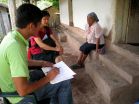Flower find provides real-time insight into evolution
A Stirling scientist who discovered a new Scottish flower has made an unexpected second finding which provides unique insight into our understanding of evolution
2015-05-06
(Press-News.org) A Stirling scientist who discovered a new Scottish flower has made an unexpected second finding which provides unique insight into our understanding of evolution.
Dr Mario Vallejo-Marin, a Plant Evolutionary Biologist at the University of Stirling, first unearthed a new species of monkeyflower on the bank of a stream in South Lanarkshire, Southern Scotland in 2012.
A subsequent expedition two years later led Dr Vallejo-Marin to locate the impressive yellow flower some 350 miles north, near Stromness on the Orkney Islands off the north coast of Scotland.
"Orkney was a missing region which hadn't been sampled," explained Dr Vallejo-Marin, Senior Lecturer in the School of Natural Sciences. "There were different varieties of monkey flower on the island, but when we spotted this population I knew it was unusual as after looking at hundreds of plants, you get to recognise the subtle differences.
"Usually a species forms once in a particular location then spreads to other regions. In this case, the opposite has occurred as the same species has evolved multiple times in different places. It shows that when the conditions are right, the origin of species is a repeatable phenomenon."
After the initial discovery, Dr Vallejo-Marin named the species Mimulus peregrinus - which translates as 'the foreigner' - given its origins from two invasive species first brought to the UK from the USA and South America in the 1800s.
It was a particularly rare find given hybrid plants of its kind are normally infertile. Instead, it doubled the amount of DNA in its cells and evolved to form a new species in a process known as polyploidisation, the same mechanism by which Wheat, Cotton and Tobacco originated.
Dr Vallejo-Marin added: "It is impossible to say whether Mimulus peregrinus evolved first in the south or in the north of Scotland, but our discovery of a very young species of this kind has allowed us to study evolution as it happens. We only know of a handful of other plant species as young as Mimulus peregrinus and so in this respect it is like looking at the big bang in the first milliseconds of its occurrence.
"The process of evolution it has followed is particularly interesting and adds complexity to our conception of the tree of life. Instead of branching out as it grows, Mimulus peregrinus is an example of how some branches can come back together again and spawn new species that are in part the combination of their ancestors."
INFORMATION:
Dr Vallejo-Marin's research is published in the Journal Evolution. The research was completed with UK colleagues from Queen Mary University of London and with Whitman College and the College of William and Mary in the USA.
Notes for editors:
The full paper can be viewed in the Journal Evolution. http://stir.ac.uk/t0
[Attachments] See images for this press release:


ELSE PRESS RELEASES FROM THIS DATE:
2015-05-06
There are now over 80,000 apps marketed as "educational" in the Apple app store, the majority of which are targeted towards children and even babies. Parents are led to believe that these apps provide real learning opportunities for their children, but scientific research suggests that many of the apps are nothing more than digital candy.
"Many apps marketed as 'educational' are basically the equivalent of sugary foods," says Kathy Hirsh-Pasek of Temple University, co-author on a new report investigating educational apps. "At best, most of these apps will do no harm; ...
2015-05-06
NEW YORK (May 6, 2015) -- To fence or not to fence? That is the question facing conservationists concerned with barriers that keep wildlife in and people out.
According to a new study by the Zoological Society of London (ZSL), Wildlife Conservation Society (WCS) and other groups, appearing in April 20 edition of the Journal of Applied Ecology, new policies must be developed before fences are erected - particularly in dryland ecosystems where mobility is essential for both humans and wildlife.
Some nations are considering fences as a means to protect remnant wildlife ...
2015-05-06
This news release is available in German.
An X-ray study carried out at DESY allows to improve the quality of chocolate. The study offers new insights into the formation of fat bloom, an unwelcome white layer that occasionally forms on chocolate. "Although fat blooming is perfectly harmless, it causes millions in damage to the food industry as a result of rejects and customer complaints," explains the main author of the study, Svenja Reinke, from the Hamburg University of Technology (TUHH). "Despite this well known quality issue, comparatively little has been known ...
2015-05-06
(BOSTON) - Increasingly, scientists across the world and in the Unites States are reporting new and groundbreaking innovations in biotechnology with transformative implications in human health and environmental sustainability. Examples range from synthetically created, metabolically-engineered bacteria for the sustainable production of fuel to gene editing therapies that could one day help in the prevention and treatment of a large number of human diseases.
While these technologies are developed in laboratories, researchers are not only giving utmost consideration to ...
2015-05-06
New Haven, Conn. - Convincing a large group of people to change its behavior is no popularity contest, a new study shows.
In a novel experiment, researchers found that certain public health interventions work best when key "influencers" in a face-to-face social network are exposed to the program. What's surprising, they say, is that those key influencers are not the most socially connected people in the network.
Furthermore, those individuals can be identified through a survey method informed by network structure rather than costly and time-consuming social network mapping. ...
2015-05-06
Maybe it's not such a dog-eat-dog world after all. A clever combination of two different types of computer simulations enabled a group of Illinois researchers to uncover an unexpectedly cooperative group dynamic: the spontaneous emergence of resource sharing among individuals in a community. Who were the members of this friendly, digitally represented collective? Escherichia coli, rod-shaped bacteria found in the digestive systems of humans and many other animals.
The finding, initially predicted by mathematical models and then confirmed through empirical testing, was ...
2015-05-06
Chocolate is one of the world's most popular foods, but when a whitish coating called a bloom appears on the confection's surface, it can make consumers think twice about eating it. The coating is made up of fats and is edible, but it changes the chocolate's appearance and texture -- and not for the better. Now scientists report in the journal ACS Applied Materials & Interfaces new information that could help chocolatiers prevent blooms from forming.
Svenja K. Reinke and colleagues explain that baked goods and confectionery products, including chocolate, contain a mix ...
2015-05-06
WASHINGTON, DC (May 6, 2015) -- Patients with a history of trauma can benefit from working with healthcare providers who understand trauma's role in health and can offer resources to assist with healing. A commentary published today in the journal Women's Health Issues proposes an approach to providing such trauma-informed primary care (TIPC). Edward L. Machtinger, MD, director of the Women's HIV Program (WHP) at the University of California, San Francisco, and his co-authors identify four core components of a TIPC approach: environment, screening, response, and a robust ...
2015-05-06
Diagnosing a heart attack can require multiple tests using expensive equipment. But not everyone has access to such techniques, especially in remote or low-income areas. Now scientists have developed a simple, thermometer-like device that could help doctors diagnose heart attacks with minimal materials and cost. The report on their approach appears in the ACS journal Analytical Chemistry.
Sangmin Jeon and colleagues note that one way to tell whether someone has had a heart attack involves measuring the level of a protein called troponin in the person's blood. The protein's ...
2015-05-06
Conventional silicon-based computing, which has advanced by leaps and bounds in recent decades, is pushing against its practical limits. DNA computing could help take the digital era to the next level. Scientists are now reporting progress toward that goal with the development of a novel DNA-based GPS. They describe their advance in ACS' The Journal of Physical Chemistry B.
Jian-Jun Shu and colleagues note that Moore's law, which marked its 50th anniversary in April, posited that the number of transistors on a computer chip would double every year. This doubling has ...
LAST 30 PRESS RELEASES:
[Press-News.org] Flower find provides real-time insight into evolution
A Stirling scientist who discovered a new Scottish flower has made an unexpected second finding which provides unique insight into our understanding of evolution




